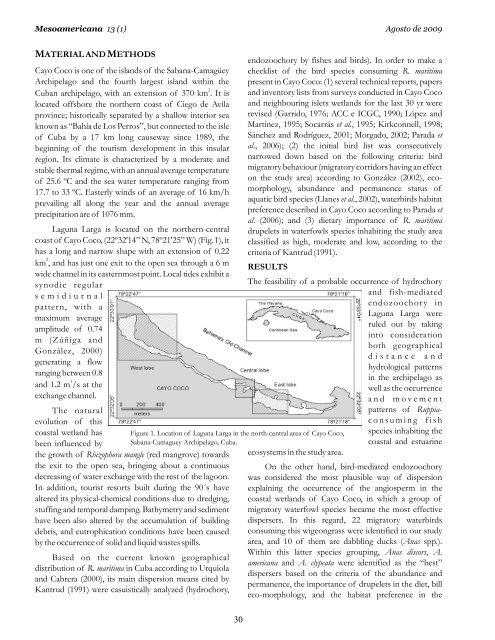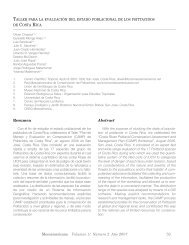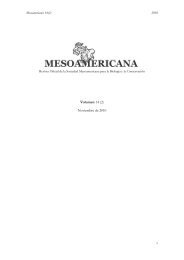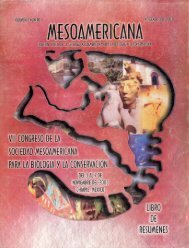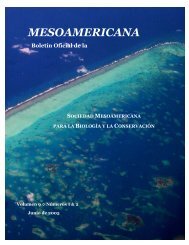MESOAMERICANA - Sociedad Mesoamericana para la BiologÃa y la ...
MESOAMERICANA - Sociedad Mesoamericana para la BiologÃa y la ...
MESOAMERICANA - Sociedad Mesoamericana para la BiologÃa y la ...
You also want an ePaper? Increase the reach of your titles
YUMPU automatically turns print PDFs into web optimized ePapers that Google loves.
<strong>Mesoamericana</strong> 13 (1) Agosto de 2009<br />
MATERIAL AND METHODS<br />
Cayo Coco is one of the is<strong>la</strong>nds of the Sabana-Camagüey<br />
Archipe<strong>la</strong>go and the fourth <strong>la</strong>rgest is<strong>la</strong>nd within the<br />
2<br />
Cuban archipe<strong>la</strong>go, with an extension of 370 km . It is<br />
located offshore the northern coast of Ciego de Avi<strong>la</strong><br />
province; historically se<strong>para</strong>ted by a shallow interior sea<br />
known as “Bahía de Los Perros”, but connected to the isle<br />
of Cuba by a 17 km long causeway since 1989, the<br />
beginning of the tourism development in this insu<strong>la</strong>r<br />
region. Its climate is characterized by a moderate and<br />
stable thermal regime, with an annual average temperature<br />
of 25.6 ºC and the sea water temperature ranging from<br />
17.7 to 33 ºC. Easterly winds of an average of 16 km/h<br />
prevailing all along the year and the annual average<br />
precipitation are of 1076 mm.<br />
Laguna Larga is located on the northern-central<br />
coast of Cayo Coco, (22º32'14” N, 78º21'25” W) (Fig. 1), it<br />
has a long and narrow shape with an extension of 0.22<br />
2<br />
km , and has just one exit to the open sea through a 6 m<br />
wide channel in its easternmost point. Local tides exhibit a<br />
synodic regu<strong>la</strong>r<br />
s e m i d i u r n a l<br />
pattern, with a<br />
maximum average<br />
amplitude of 0.74<br />
m (Zúñiga and<br />
González, 2000)<br />
generating a flow<br />
ranging between 0.8<br />
3<br />
and 1.2 m /s at the<br />
exchange channel.<br />
The natural<br />
evolution of this<br />
coastal wet<strong>la</strong>nd has<br />
been influenced by<br />
the growth of Rhizophora mangle (red mangrove) towards<br />
the exit to the open sea, bringing about a continuous<br />
decreasing of water exchange with the rest of the <strong>la</strong>goon.<br />
In addition, tourist resorts built during the 90´s have<br />
altered its physical-chemical conditions due to dredging,<br />
stuffing and temporal damping. Bathymetry and sediment<br />
have been also altered by the accumu<strong>la</strong>tion of building<br />
debris, and eutrophication conditions have been caused<br />
by the occurrence of solid and liquid wastes spills.<br />
Based on the current known geographical<br />
distribution of R. maritima in Cuba according to Urquio<strong>la</strong><br />
and Cabrera (2000), its main dispersion means cited by<br />
Kantrud (1991) were casuistically analyzed (hydrochory,<br />
endozoochory by fishes and birds). In order to make a<br />
checklist of the bird species consuming R. maritima<br />
present in Cayo Coco: (1) several technical reports, papers<br />
and inventory lists from surveys conducted in Cayo Coco<br />
and neighbouring islets wet<strong>la</strong>nds for the <strong>la</strong>st 30 yr were<br />
revised (Garrido, 1976; ACC e ICGC, 1990; López and<br />
Martínez, 1995; Socarrás et al., 1995; Kirkconnell, 1998;<br />
Sánchez and Rodríguez, 2001; Morgado, 2002; Parada et<br />
al., 2006); (2) the initial bird list was consecutively<br />
narrowed down based on the following criteria: bird<br />
migratory behaviour (migratory corridors having an effect<br />
on the study area) according to González (2002), ecomorphology,<br />
abundance and permanence status of<br />
aquatic bird species (L<strong>la</strong>nes et al., 2002), waterbirds habitat<br />
preference described in Cayo Coco according to Parada et<br />
al. (2006); and (3) dietary importance of R. maritima<br />
drupelets in waterfowls species inhabiting the study area<br />
c<strong>la</strong>ssified as high, moderate and low, according to the<br />
criteria of Kantrud (1991).<br />
RESULTS<br />
Figure 1. Location of Laguna Larga in the north-central area of Cayo Coco,<br />
Sabana-Camaguey Archipe<strong>la</strong>go, Cuba.<br />
30<br />
The feasibility of a probable occurrence of hydrochory<br />
and fish-mediated<br />
endozoochory in<br />
Laguna Larga were<br />
ruled out by taking<br />
into consideration<br />
both geographical<br />
d i s t a n c e a n d<br />
hydrological patterns<br />
in the archipe<strong>la</strong>go as<br />
well as the occurrence<br />
a n d m o v e m e n t<br />
patterns of Ruppiac<br />
o n s u m i n g f i s h<br />
ecosystems in the study area.<br />
species inhabiting the<br />
coastal and estuarine<br />
On the other hand, bird-mediated endozoochory<br />
was considered the most p<strong>la</strong>usible way of dispersion<br />
exp<strong>la</strong>ining the occurrence of the angiosperm in the<br />
coastal wet<strong>la</strong>nds of Cayo Coco, in which a group of<br />
migratory waterfowl species became the most effective<br />
dispersers. In this regard, 22 migratory waterbirds<br />
consuming this wigeongrass were identified in our study<br />
area, and 10 of them are dabbling ducks (Anas spp.).<br />
Within this <strong>la</strong>tter species grouping, Anas discors, A.<br />
americana and A. clypeata were identified as the “best”<br />
dispersers based on the criteria of the abundance and<br />
permanence, the importance of drupelets in the diet, bill<br />
eco-morphology, and the habitat preference in the


